- Home
- Composition
- Rule of Thirds
The Rule of Thirds Creates Easy Compositions
Start creating easy compositions in your paintings with the rule of thirds. This time-honored technique has been used by artists and photographers for centuries.
You'll be able to create dynamic, balanced, and engaging paintings that draw the viewer's eye and hold their attention.
On this page, we'll look into the history of the rule of thirds, explore its various applications and provide practical tips for incorporating it into your own paintings.
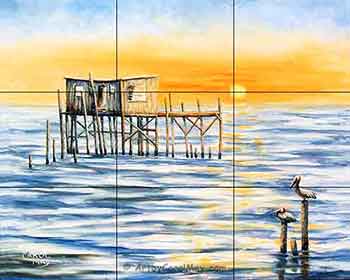 Create engaging compositions!
Create engaging compositions!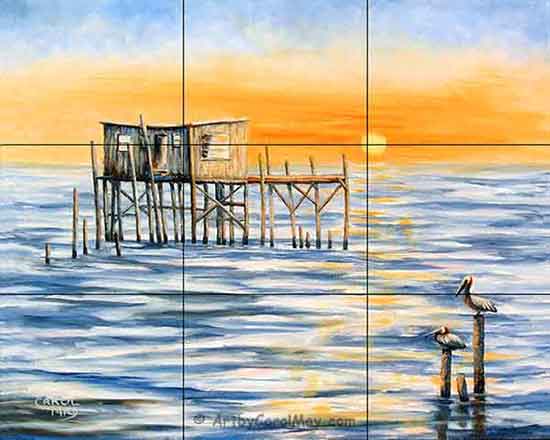 Create engaging compositions!
Create engaging compositions!Rule of Thirds: A Centuries-old Secret
This time-honored technique was first written about in the 1700s.
The suggestion was to paint everything in a 2:1 proportion. Such as, two thirds light and one third dark values or one third land with two thirds sky or vice versa, etc.
Today many artists and photographers use the rule to create captivating artwork.
What's the Benefit of the Rule of Thirds?
The rule of thirds is the artist's shortcut for easy compositions.
This is especially useful for the beginning artist. They can concentrate on the painting process because a good composition is a done deal.
It Creates a Balanced Composition
Today's artists use the rule to place the painting's focal point at a two-thirds position.
This easy technique creates balanced, engaging paintings that draw the viewer's eye and hold their attention.
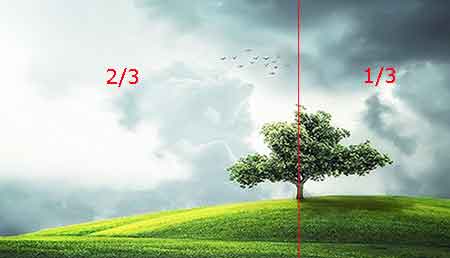 An easy way to balance a painting.
An easy way to balance a painting.We place our subject, (the focal point) one third of the way into the painting.
The rest of the painting takes up the remaining two thirds of the space. This creates a balanced painting.
A painting with unequal parts is more interesting and attractive to the viewers.
The focal subject draws the people in. Then their eyes have space to move around in the other parts of the painting.
How Do We Use the Rule of Thirds in Paintings?
It involves dividing the painting surface into nine equal parts and placing the main subject along these lines or at the intersections of the lines.
This strategic placement of the subject creates a sense of harmony and tension that makes our paintings more interesting and visually appealing.
First divide the canvas into thirds.
I often do the third lines on paper before transferring the drawing to the canvas.
Place two lines vertically up and down at one third and two thirds of the format, numbers 1 & 2.
Then place two lines horizontally across the canvas at the one third and two thirds' divisions of the canvas, numbers 3 & 4.
This divides the canvas into nine parts.
Where Do We Place the Focal Point?
Place the subject of the painting at one of the four intersections of the lines.
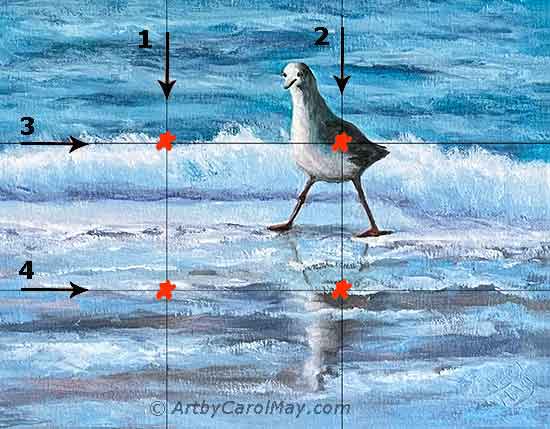 Try this for super easy composition.
Try this for super easy composition.Put the focal point near any red X.
Any intersection will work, but the top ones are best. People tend to look at things from the top down, so they will take more time to look at the rest of the painting.
The subject does not have to be exactly dead-center on the intersections.
They may also, be placed anywhere on the third lines, up or down or across.
Any position on the third lines will create a visually appealing composition.
Show Me Examples of Paintings Using the Thirds Rule
The thirds rule works the same in all formats. We can use this easy rule to create a composition for any size or shape of canvas.
Although there are many items in the "Sea Shells" painting, the main subject is the white coral. It is placed along the top horizontal third line, but not centered.
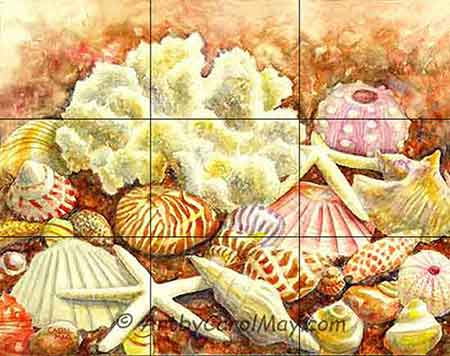 Horizontal format
Horizontal formatIn a vertical format the "Gulf Fritillary" is placed at one of the intersections of the third lines.
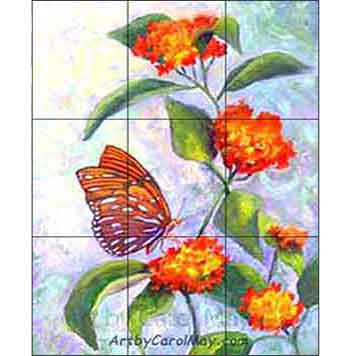 Vertical painting
Vertical painting"Tropical Beauty" on a round canvas has the hummingbird placed on one of the top intersections.
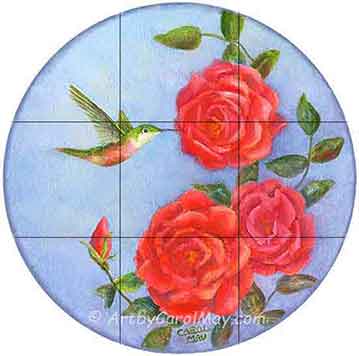 Round canvas
Round canvasWhere Is the Best Place for the Focal Point?
In our culture most of us read from left to right.
So, an intersection on the right side is considered the ideal place for the focal point.
This works for both vertical and horizontal subjects.
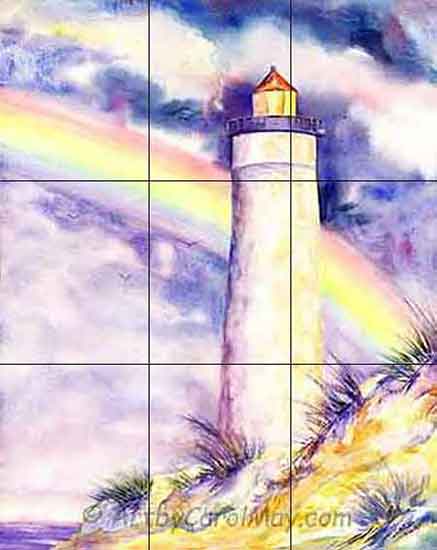 Use the vertical lines for tall subjects.
Use the vertical lines for tall subjects.Vertical subjects like a high waterfall, a tree, a tall building, or even a lighthouse may be placed on or near one of the vertical third lines.
The remaining two thirds of the painting balances the tall object.
Horizontal subjects like long, low buildings could be placed on one of the horizontal third lines.
Additionally, the lines of land or water may be placed at or near one of the horizontal third lines.
This would give us the 2:1 ratio of land to sky or land to water.
That's what the artists were talking about in their writings back in the 1700s.
Create a Secondary Focal Point
A second focal point gives the viewers more to look at and keeps them interested in the painting.
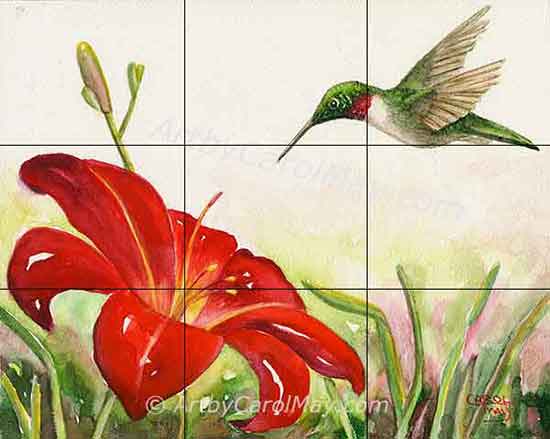 A second focal point creates more dynamics.
A second focal point creates more dynamics.We may place a second subject at another intersection of the third lines.
In this painting the hummingbird and the flower are each placed at an intersection of the third lines.
They are placed diagonally across from each other.
Diagonal lines create a dynamic tension and indicate action in a painting.
Plus, the hummingbird is looking at the flower. His gaze guides the viewer's eye to the flower.
It creates a feeling of movement and action in the painting. You may want to see more hummingbird paintings.
Are There Exceptions to the Rules?
Do artists always place the focal point on the third lines? Do we have to avoid putting the subject on the center lines.
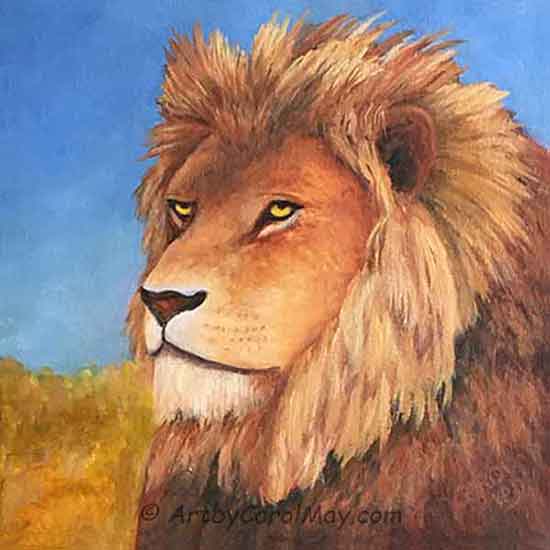 Portraits place the subject at a 3/4 view.
Portraits place the subject at a 3/4 view.There are always exceptions to any rule.
Portraits of people or animals may have the subject placed in the center of the painting.
However, when we are painting portraits, it's best to place the subject at a three quarters view.
This means the subject is not looking directly at the viewer. Nor is it looking straight out the side of the painting, but half-way in between.
This creates more interest and changes the painting from being completely symmetrical.
Do Artists Always Follow the Rule of Thirds?
Of course not, but it's an excellent tool for the artist's tool belt.
Using the thirds rule creates dynamic and balanced compositions.
We can confidently count on a good composition and turn our attention to color and other painting skills.
As you continue to grow and develop as an artist, be sure to check out more articles and tutorials on ArtbyCarolMay.com.






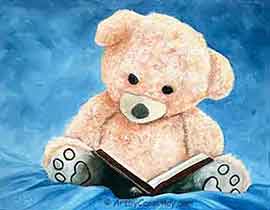 Are you eager to learn how to oil paint? What are the essential supplies for oil painting? What do we need for clean-up and how long do oil paintings take to dry? Learn the rules of oil painting and t…
Are you eager to learn how to oil paint? What are the essential supplies for oil painting? What do we need for clean-up and how long do oil paintings take to dry? Learn the rules of oil painting and t…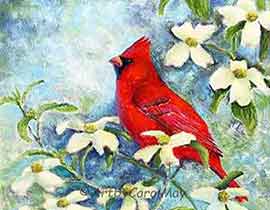 How do we create a focal point in art? Where do we put the focal point? How do we find the focus of an artwork? Should all paintings have a center of interest or can they have more than one? Learn fro…
How do we create a focal point in art? Where do we put the focal point? How do we find the focus of an artwork? Should all paintings have a center of interest or can they have more than one? Learn fro…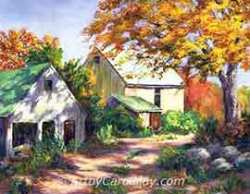 Art elements and principles appear over and over in good paintings. The elements and principles work together for us to create successful artwork. Art principles are the rules that govern how an artis…
Art elements and principles appear over and over in good paintings. The elements and principles work together for us to create successful artwork. Art principles are the rules that govern how an artis…